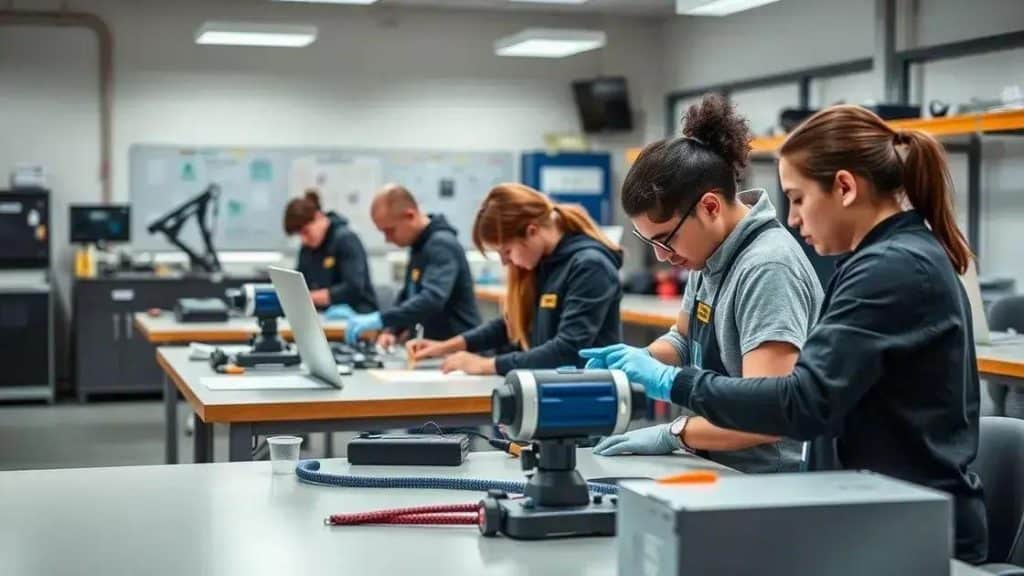Increase in funding for vocational and technical education

An increase in funding for vocational and technical education directly enhances program quality, expands access to job training, and significantly improves employment outcomes for graduates, benefiting both individuals and local economies.
Increase in funding for vocational and technical education could be a game changer for many aspiring professionals. Imagine a world where everyone has access to high-quality technical training, leading to better jobs and brighter futures.
Understanding the importance of vocational education
Understanding vocational education is crucial in today’s rapidly evolving job market. It prepares students for specific careers by providing them with hands-on training and practical skills.
Vocational education focuses on direct job skills rather than theoretical knowledge, making it an ideal choice for many students. It helps to bridge the skills gap that many employers face today.
Benefits of vocational education
Students who pursue vocational education often gain a competitive edge in the labor market. Here are some key benefits:
- Increased job opportunities: Graduates often find it easier to secure employment.
- Higher earning potential: Many vocational careers offer salaries that are competitive with traditional four-year degree paths.
- Hands-on experience: Students learn by doing, which can lead to a better understanding of their chosen field.
Many programs also partner with local industries, allowing students to gain real-world experience while studying. This connection with businesses helps students to network and build relationships that can lead to job placements after graduation. Furthermore, vocational education is often more affordable than traditional college pathways, making it accessible to a broader range of students.
Addressing workforce needs
As industries constantly evolve, vocational programs adapt curricula to meet changing workforce demands. This responsiveness ensures that students are trained in the latest technologies and practices relevant to their field.
With an increase in funding for vocational education, schools can enhance their programs, offering better facilities, updated equipment, and more specialized training. Ultimately, this leads to a more skilled workforce that can significantly impact the economy.
Key benefits of increased funding

Increased funding for vocational education can lead to amazing opportunities for students and communities. Not only does it provide more resources, but it also enhances the quality of education offered.
With more funds, schools can hire skilled instructors who bring real-world experience into the classroom. This means students get the best training possible, preparing them for the workforce. Additionally, better funding allows institutions to update their facilities and equipment, ensuring that students learn with the latest tools in their field.
Enhancing program offerings
Increased funding helps to diversify and improve vocational programs significantly. It can support:
- New courses: Schools can develop courses to meet the evolving demands of various industries.
- Expanded access: More funding can provide scholarships and financial aid to students who might otherwise miss out.
- Industry partnerships: Schools can form partnerships with local businesses, providing students with valuable internships and job placements.
As programs expand, students gain exposure to a wider range of career paths. They can explore various fields, helping them to find their true interests and strengths.
Sparking economic growth
Beyond education, increased funding contributes to economic growth in the community. As vocational training programs produce skilled workers, businesses benefit from having qualified candidates available. This not only boosts employment rates but also helps local economies thrive.
Moreover, when residents have access to well-paying jobs, it leads to higher consumer spending, benefiting local businesses and creating a positive economic cycle. Investment in vocational education is indeed an investment in the future of the community.
Challenges in securing funding for technical education
Securing funding for technical education presents various challenges that can hinder the growth of vocational programs. These challenges often arise from both institutional and governmental levels.
Many institutions face budget constraints that limit their ability to offer comprehensive vocational programs. A lack of understanding about the value of technical education can lead to insufficient funding allocations from state and local governments. This can prevent schools from hiring qualified teachers, purchasing necessary equipment, and developing effective curricula.
Common barriers to funding
Here are some common barriers that contribute to the challenges:
- Limited awareness: Many policymakers do not recognize the significant role that vocational education plays in workforce development.
- Competition for resources: Funding is often spread thin across various educational sectors, making it difficult for technical programs to secure adequate support.
- Bureaucratic hurdles: The process for applying for and receiving funding can be complex and time-consuming, discouraging institutions from pursuing it.
Furthermore, fluctuating economic conditions can impact available funding for educational programs. When budgets tighten, vocational programs are often among the first to face cuts. Some communities struggle with local industries that may not invest in training initiatives, leaving programs under-resourced.
Addressing funding difficulties
Despite these challenges, there are strategies that can help schools secure the funding they need. Building strong partnerships with local businesses can lead to increased investment in vocational training. These partnerships not only help with funding but can also provide students with valuable internship opportunities.
Moreover, advocating for policy changes at the state and federal levels can highlight the importance of robust vocational education funding. By raising awareness of the impact that technical education has on the economy, stakeholders can encourage better financial support for programs.
Successful case studies of funded programs

Examining successful case studies of funded programs can provide valuable insights into the effectiveness of increased financial support for vocational education. These examples highlight how targeted funding can lead to amazing outcomes for students and communities.
For instance, one notable program in Texas has seen remarkable success after receiving a significant funding boost. This program focused on advanced manufacturing skills, aligning its training with local industry needs. As a result, graduates consistently find jobs shortly after completing their classes.
Key success factors
Some factors that contribute to the success of these programs include:
- Industry partnerships: Collaborating with local businesses ensures the curriculum meets current job market demands.
- Comprehensive support services: Providing tutoring, mentorship, and financial aid helps students succeed.
- Real-world experience: Incorporating internships or apprenticeships gives students valuable hands-on training.
Another program in Florida focused on healthcare vocational training. After receiving state funding, it expanded its offerings and capacity, allowing more students to enroll. The program’s graduates now fill essential healthcare roles in their communities, showcasing the profound impact of vocational education.
Measuring impact
Measuring the impact of these funded programs is essential. Successful initiatives often conduct regular evaluations to assess student outcomes, job placement rates, and employer satisfaction. By tracking this data, schools can continuously improve their programs and demonstrate the effectiveness of vocational education to potential funders.
These case studies illustrate how increased funding can transform vocational education. They not only enhance students’ career prospects but also support local economies and meet labor demands, paving the way for brighter futures.
FAQ – Frequently Asked Questions about Vocational and Technical Education Funding
What are the main benefits of increased funding for vocational education?
Increased funding enhances training quality, expands program offerings, and improves job placement rates for graduates.
How can successful case studies influence future funding efforts?
Successful case studies demonstrate the effectiveness of vocational programs, making a compelling case for more financial support from stakeholders.
What challenges do vocational programs face when securing funding?
Common challenges include limited awareness among policymakers, competition for resources, and bureaucratic hurdles in the funding process.
Why is vocational education important for local economies?
Vocational education prepares skilled workers, boosts employment, and contributes to economic growth by meeting industry needs.





